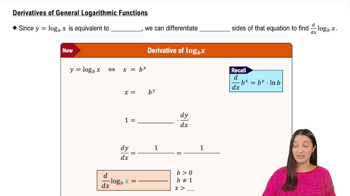Calculate the derivative of the following functions (i) using the fact that bx = exIn b and (ii) using logarithmic differentiation. Verify that both answers are the same.
y = (4x+1)In x
 Verified step by step guidance
Verified step by step guidance Verified video answer for a similar problem:
Verified video answer for a similar problem:



 6:30m
6:30mMaster Logarithmic Differentiation with a bite sized video explanation from Patrick
Start learning